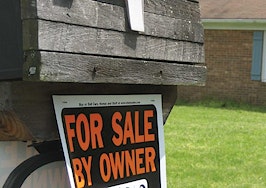- Nearly half of all families living in single-family rental homes have children under the age of 18 compared to 27 percent of apartment dwellers. One-third of rental home families have children under the age of six.
- Single-family home renters are older than apartment dwellers and earn more.
- However, when they're ready to buy, they'll be surfing listings and browsing how-to blogs like any other prospective buyer. Single-family renters are hard to market.
Where can you find mature, motivated buyers with growing families and community roots, who have saved for their down payment, put their credit in order and know how to maintain and enjoy living in a single-family home?
More than 14 million households live in single-family rental homes today. Two out of three want to own a home, and they’ve been using their time as renters to get ready. Single-family rentals have become stepping-stones to homeownership.
[Tweet “More than 14 million households live in single-family rental homes today. “]
Some real estate economists reacted with dismay when investors converted more than 4 million foreclosures into rentals between 2007 and 2012, even though they saved home values in foreclosure hotbeds in the four sand states — California, Arizona, Nevada and Florida — from plunging even more than they did.
Then when the recovery began in earnest two years ago, many expected landlords to list their rental properties — the vast majority of which are lower-priced starter homes — and return then to ownership status. That hasn’t happened to any large degree, at least not enough to relieve soaring prices in hot markets because of rent prices.
Rent prices are rising nearly as fast as home prices, and landlords are doing well these days holding on to their fast-appreciating cash-flow cows. Meanwhile, their tenants struggle to pay higher rents and save for down payments at the same time.
When I conducted a national survey of them two and a half years ago using one of the nation’s top opinion research firms, we found that only 26 percent intended to stay where they were for more than five years, and at least 60 percent planned to become homeowners by 2018.
On surveys like that one, intentions usually do match reality. The rising rents mentioned above, unchanging lending mortgage lending standards and the anemic income growth has no doubt delayed many families’ plans.

A wave of new buyers — as many as 8 million young families who have been living in rentals for as long as five years — are now ready to buy, with the help of agents who can supply the services and expertise to help them make the transition.
[Tweet “As many as 8 million young families that have been living in rentals for as long as five years.”]
More single-family renters are young families
But prices aren’t rising quickly everywhere, and real estate professionals looking for buyers should look beyond the traditional apartment hunting grounds to single-family rentals, where they will find more mature and motivated potential buyers. Many of those buyers are boomerang buyers who lost their homes in the crash but have repaired their credit and learned a thing or two about the perils of creative lending.
Here are a few more things we learned about single-family and apartment renters from the survey sponsored by Memphis Invest:
- Nearly half of all families living in single-family rental homes have children under the age of 18, compared to 27 percent of apartment dwellers. One-third of rental home families have children under the age of six. Rental homes provide the space children need and also access to schools, playgrounds and other kids. Children are also a critical motivator for homeownership and from a rental home; families can often stay in the same neighborhood and keep kids in the same schools and social groups.
- Single-family home renters are older than apartment dwellers and earn more. Some 29 percent of single-family rental tenants are in their thirties, compared to 20 percent of apartment tenants. Median income for a single-family renter is $75,000 to 100,000 (66 percent) versus $50,000 to 75,000 (51 percent) for a multifamily tenant.
- Not surprisingly, when looking for a home, single-family renters ranked good schools (84 percent), playgrounds, (71 percent), friendly neighborhoods (94 percent) and community centers (64 percent) higher than apartment dwellers.
[Tweet “Nearly half of all families living in single-family rental homes have children under 18.”]
How to help them make the transition
Single-family renters are hard to target. They are spread across the community, living in rentals that look exactly like the ownership homes next door. However, when they’re ready to buy, they’ll be surfing listings and browsing how-to blogs like any other prospective buyer.
[Tweet “When they’re ready, they’ll be surfing listings and browsing how-to blogs like any other buyer.”]
Reach them with your blog articles, social media, seminars and branded content addressing the special services they need:
- Put together expert and current market information from your MLS and other sources on future hyperlocal market trends, not just today’s prices. They want to know what the market will look like next season when they are ready. Every day they wait is costing them money.
- Show them how much equity is rising again in your market. They are missing the boat on building personal wealth.
- Get the latest on current lending standards, especially FICOs and debt-to-income ratios, so that you can show them how close they are to being ready. Know lenders you trust who are flexible on those two sticking points. Be ready with info on how to overcome student loan debt.
- Review options on down payments, including the government-sponsored enterprise (GSE) programs, FHA, local and state down payment assistance programs.
Just because you don’t live in former foreclosure markets such as Las Vegas or Phoenix doesn’t mean you don’t have potential single-family rental clients in your community. Today, they are in virtually every market in the nation, and they are still growing. Don’t think of them as competition. Think of them as incubators for your next buyers.
[Tweet “Think of them as incubators for your next buyers.”]
Steve Cook is editor and co-publisher of Real Estate Economy Watch and provides communications consulting services to leading real estate organizations. Visit him on LinkedIn and Facebook.




